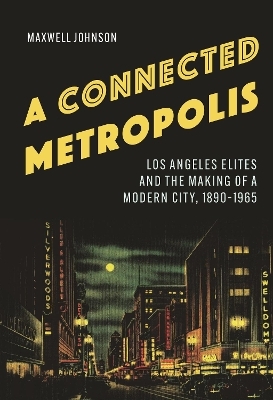
A Connected Metropolis
Los Angeles Elites and the Making of a Modern City, 1890–1965
Seiten
2023
University of Nebraska Press (Verlag)
978-1-4962-2432-3 (ISBN)
University of Nebraska Press (Verlag)
978-1-4962-2432-3 (ISBN)
A Connected Metropolis describes Los Angeles’s rise in the early twentieth century as catalyzed by a series of upper-class debates about the city’s connections to the outside world.
In A Connected Metropolis Maxwell Johnson describes Los Angeles’s rise in the early twentieth century as catalyzed by a series of upper-class debates about the city’s connections to the outside world. By focusing on specific moments in the city’s development when tensions over Los Angeles’s connections, or lack thereof, emerged, Johnson ties each movement to two or three contemporary figures who influenced the debates at hand. The elites’ previous efforts to secure nationwide and global connections for Los Angeles were wildly successful following World War II. As a result, the city became a landing spot for African American migrants, Cambodian and Laotian refugees, and Mexican and Central American immigrants. Johnson argues that the city’s history is more defined by external relationships than previously understood, and those relationships have given the history of the city more continuity than originally recognized.
At the turn of the twentieth century, the politics of connection revolved around initiatives to tie Los Angeles to other places both tangibly and metaphorically. Elites built tangible connections to secure, among other things, the water that irrigated the citrus farms of Los Angeles, the capital that propelled its businesses, and the people who migrated from the Midwest to buy its houses. To build metaphorical connections that located the city amid transcontinental and trans-Pacific movements, elites themselves often transcended nearby borders and pursued connections at will. Los Angeles stood as a focal point for elite ambitions, a place with a more ambivalent relationship to external connections. The true story of Los Angeles’s rise lies in the spectacular visions and rambunctious activism of a group of elite men dedicated to transforming a remote frontier town into a global metropolis.
In A Connected Metropolis Maxwell Johnson describes Los Angeles’s rise in the early twentieth century as catalyzed by a series of upper-class debates about the city’s connections to the outside world. By focusing on specific moments in the city’s development when tensions over Los Angeles’s connections, or lack thereof, emerged, Johnson ties each movement to two or three contemporary figures who influenced the debates at hand. The elites’ previous efforts to secure nationwide and global connections for Los Angeles were wildly successful following World War II. As a result, the city became a landing spot for African American migrants, Cambodian and Laotian refugees, and Mexican and Central American immigrants. Johnson argues that the city’s history is more defined by external relationships than previously understood, and those relationships have given the history of the city more continuity than originally recognized.
At the turn of the twentieth century, the politics of connection revolved around initiatives to tie Los Angeles to other places both tangibly and metaphorically. Elites built tangible connections to secure, among other things, the water that irrigated the citrus farms of Los Angeles, the capital that propelled its businesses, and the people who migrated from the Midwest to buy its houses. To build metaphorical connections that located the city amid transcontinental and trans-Pacific movements, elites themselves often transcended nearby borders and pursued connections at will. Los Angeles stood as a focal point for elite ambitions, a place with a more ambivalent relationship to external connections. The true story of Los Angeles’s rise lies in the spectacular visions and rambunctious activism of a group of elite men dedicated to transforming a remote frontier town into a global metropolis.
Maxwell Johnson is a humanities instructor at Park Tudor School in Indianapolis.
List of Illustrations
Acknowledgments
Introduction: “The Damnedest Place”
Snapshot: Los Angeles, 1890
1. Command Post or Outpost
2. Borderlands Fortress
Snapshot: Los Angeles, 1920
3. “Virtually on the Edge of a Desert”
4. The Perils of Exceptionalism
Snapshot: Los Angeles, 1940
5. “The Center of Japanese Intrigue and Activity in America”
Coda: “Where They All Are Headed”
Notes
Bibliography
Index
| Erscheinungsdatum | 25.05.2023 |
|---|---|
| Zusatzinfo | 10 Illustrations, index |
| Verlagsort | Lincoln |
| Sprache | englisch |
| Maße | 152 x 229 mm |
| Themenwelt | Sachbuch/Ratgeber ► Geschichte / Politik ► Regional- / Landesgeschichte |
| Geisteswissenschaften ► Geschichte ► Regional- / Ländergeschichte | |
| Geschichte ► Teilgebiete der Geschichte ► Kulturgeschichte | |
| Sozialwissenschaften ► Soziologie | |
| ISBN-10 | 1-4962-2432-9 / 1496224329 |
| ISBN-13 | 978-1-4962-2432-3 / 9781496224323 |
| Zustand | Neuware |
| Haben Sie eine Frage zum Produkt? |
Mehr entdecken
aus dem Bereich
aus dem Bereich
der stille Abschied vom bäuerlichen Leben in Deutschland
Buch | Hardcover (2023)
C.H.Beck (Verlag)
23,00 €
vom Mittelalter bis zur Gegenwart
Buch | Softcover (2024)
C.H.Beck (Verlag)
12,00 €


